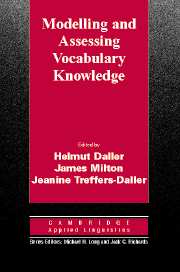Book contents
- Frontmatter
- Contents
- List of contributors
- List of abbreviations
- Acknowledgements
- Foreword
- Series Editors' Preface
- Editors' introduction
- I Fundamental issues
- II Vocabulary and learner differences
- III The unit of assessment and multiple vocabulary measures
- IV Metaphors and measures in vocabulary knowledge
- V Vocabulary measures in use
- Chapter 11 Assessing vocabulary for the purpose of reading diagnosis
- Chapter 12 The best of both worlds? Combined methodological approaches to the assessment of vocabulary in oral proficiency interviews
- Chapter 13 What is in a teacher's mind? Teacher ratings of EFL essays and different aspects of lexical richness
- References
- Appendices
- Index
Chapter 11 - Assessing vocabulary for the purpose of reading diagnosis
Published online by Cambridge University Press: 04 May 2010
- Frontmatter
- Contents
- List of contributors
- List of abbreviations
- Acknowledgements
- Foreword
- Series Editors' Preface
- Editors' introduction
- I Fundamental issues
- II Vocabulary and learner differences
- III The unit of assessment and multiple vocabulary measures
- IV Metaphors and measures in vocabulary knowledge
- V Vocabulary measures in use
- Chapter 11 Assessing vocabulary for the purpose of reading diagnosis
- Chapter 12 The best of both worlds? Combined methodological approaches to the assessment of vocabulary in oral proficiency interviews
- Chapter 13 What is in a teacher's mind? Teacher ratings of EFL essays and different aspects of lexical richness
- References
- Appendices
- Index
Summary
Introduction
This chapter, and the others in this part, take up the challenge raised by Nation in the opening chapter, to investigate vocabulary in use in order to gain a balanced picture of overall vocabulary knowledge. It focuses upon vocabulary assessment as part of the general language screening that is carried out by many secondary schools in multilingual settings. It is argued that the assessment of vocabulary, as a part of reading diagnosis, may shed light on diverse reading problems that both L1 and L2 students encounter at school. It may help answer the question which is often raised by these problems: Are we dealing with a reading problem or a language problem?
In the past decades, the school population in the Netherlands, as in many other European countries, has become more and more linguistically diverse as a consequence of immigration. Currently, some 15% of students in their first year of secondary education are non-native, and some inner city schools welcome more than 80% immigrant students. For most of them, Dutch is the second language, although there is much variety in the use of home and school languages. As a result of the growing diversity of the school population, there is a need for a general assessment of academic language proficiency of students in their first year of secondary school.
- Type
- Chapter
- Information
- Modelling and Assessing Vocabulary Knowledge , pp. 207 - 219Publisher: Cambridge University PressPrint publication year: 2007
- 1
- Cited by



